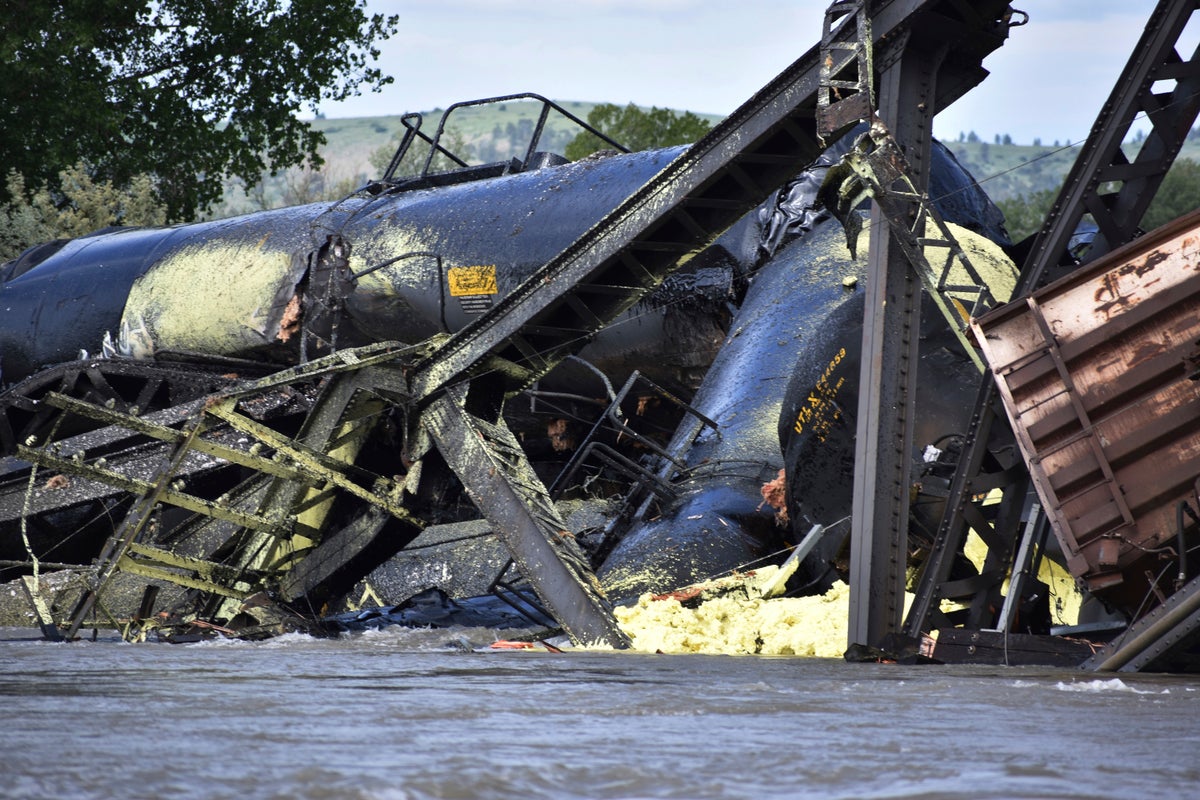
Tar balls have shown up 100 miles (160.93 kilometers) downstream of a railroad bridge collapse last month that sent numerous tank cars carrying petroleum products plummeting into Montana's Yellowstone River, officials said Friday, as dropping water levels and rising temperatures hinder cleanup work.
More than 66 tons (59.87 metric tonnes) of the black, gooey stuff have been removed from the river since the June 24 accident, officials said. Most of the spilled material — a binder for asphalt that sticks to river rocks and gets harder to handle as it warms — is expected to get left behind.
Cleanup crews working this week on an island near the town of Laurel pulled long, taffy-like pieces of the asphalt from among the river rocks. They used shovels to pull apart sandbanks where receding water levels revealed pockets of contamination. The globs — along with some rocks and sand — were bagged for disposal and carried away by power boat.
Navigating the river is getting harder by the day for the boats being used in the cleanup. And when temperatures peak in the afternoons, the asphalt becomes too soft to pick up, curtailing work. Smaller clumps and some asphalt enmeshed in river rocks will be left behind.
“Some of this oil will be left here,” said Andrew Graham, an environmental scientist and consultant for the cleanup. “There's no way we're going to get all of the asphalt off of the river....We're really looking at the stuff that we can peel up and getting the bulk of the product off."
Tar mats and tar balls from the spill have been found at more than three dozen locations, according to government records. That includes where the river passes through Montana’s largest city, Billings. The farthest site downstream is near Pompey’s Pillar National Monument.
Montana Rail Link of Missoula operated the train and is responsible for the cleanup.
The company predicted immediately after the spill that the petroleum products would “solidify rapidly." Authorities now say the material could take much longer to harden.
Representatives of the railroad, which is being acquired by Texas-based BNSF in a deal that will be finalized next year, did not return email and telephone messages seeking comment.
State officials are preparing to notify Montana Rail Link that the spill violated Montana pollution laws, said Montana Department of Environmental Quality spokesperson Kevin Stone. The agency still is considering its enforcement options, and hasn't yet determined at what point it will declare the cleanup sufficient, Stone said.
The Environmental Protection Agency previously estimated up to 250 tons (226.80 metric tonnes) of oil product entered the river from six asphalt binder tank cars. Agency spokesperson Beth Archer said Friday that officials still were determining a final figure.
Seven snakes and seven birds have been killed after coming into contact with tar mats or tar balls. One snake was cleaned and released.
Yet officials say the material is fairly benign if not touched and doesn't pose a long-term health threat for the people who boat, swim and fish in the Yellowstone.
“It's like a fouling issue,” said Graham. “Once it gets on you, your body temperature will warm it up and it gets sticky. You need to use baby oil to get it off. It's very difficult to get off with soap and water.”
No drinking water contamination has been found.
A smaller amount of molten sulfur spilled from three tank cars. It hardened after being released and very little has been found on the river, according to Archer and others involved in the cleanup.
The cause of the bridge collapse remains under investigation, said Federal Railroad Administration spokesperson Daniel Green.
It happened at a time when the river was swollen with melting mountain snow and following a torrential rainfall. Yellowstone National Park is about 130 miles (209.21 kilometers) upstream and wasn’t impacted.
The derailment marked the Yellowstone's third large petroleum spill in recent years, following crude oil pipeline breaks in 2011 and 2015. The Yellowstone has a shifting channel and its river bed can become severely scoured during flooding such as the region experienced last year.
Experts say those forces could have made the railroad bridge more unstable and contributed to its collapse.
No one was injured, but the accident added to growing scrutiny of the rail industry brought on by high-profile accidents including a February derailment in East Palestine, Ohio, that sparked a fire and evacuations and led to the eventual burning of hazardous materials to prevent an uncontrolled explosion.
Union leaders say freight train inspections are happening less often and are not as thorough as in the past due to staff cuts and time constraints.







